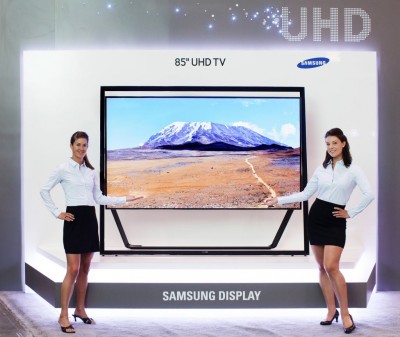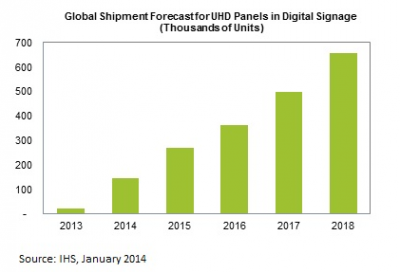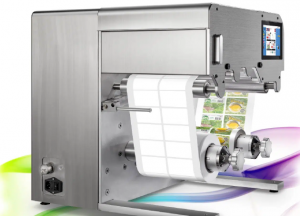UHD panels hit the digital signage market

The ultra-high-definition (UHD) panels now being adopted by TV manufacturers are also primed to make significant headway this year in the digital signage market, according to analysts at IHS Technology.
According to the market research firm’s digital signage service, shipments of UHD panels—also known as ‘4K’ displays—intended specifically for digital out-of-home (DOOH), communication and commercial applications in the digital signage market will reach 145,000 units in 2014, up nearly 600 per cent from a mere 21,000 units in 2013. As such, this year will mark the first real ‘growth spurt’ for the panels after an initially low customer base.
Following this tremendous surge, IHS anticipates the market will continue to support further expansion in the years to come, with UHD digital signage shipments approaching 656,000 by 2018 (see chart, below). And as the technology becomes more readily available, display costs are expected to decline.
The groundwork for this market trend was laid in 2013, when the first 4K digital signage was installed for a wayfinding system in McCarran International Airport in Las Vegas, Nev., followed by panels in Delta Airlines’ passenger lounges in other U.S. airports (see Sign Media Canada, November 2013, page 35). At the same time, technology firms began to unveil UHD-compatible content management software and media players.

Even as more 4K installations reach price-sensitive digital signage markets and content is repurposed from the consumer market, however, such panels will constitute a mere drop in the bucket compared to the overall UHD market. Shipments of UHD TVs, by way of comparison, are expected to reach 10 million units in 2014 and some 40 million by 2018.
Many of the panel manufacturers, including LG, Samsung (example pictured, above) and Sony, are the same for both markets. IHS suggests this could muddle the distinction between consumer- and commercial-grade displays, which may be problematic given the specific requirements of the digital signage industry in terms of hardware and software for disseminating content.
Other obstacles include infrastructure and investment costs associated with upgrading digital signage networks, the requirement for additional bandwidth to support 4K content and the need to harmonize specifications for frame rates, brightness, dynamic range and other metrics that could be affected by resolution upgrades.


